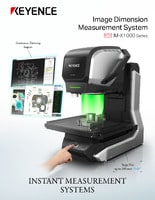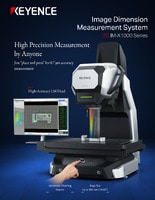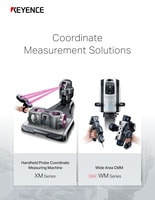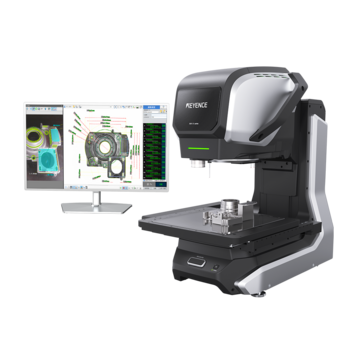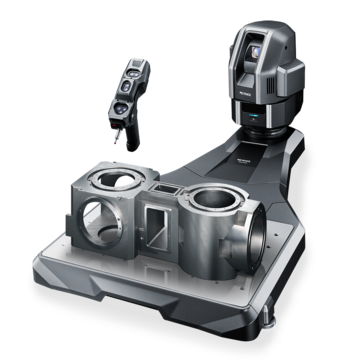Optical Comparator (Profile Projector)
Selecting Measurement Systems by Measurement Speed
Key Takeaways
- Prioritize measurement speed that matches production: real‑time for moving parts, batch for stationary.
- Balance speed with accuracy; avoid sacrificing precision for throughput in critical tolerances.
- Prefer automated image or multisensor systems for high‑volume, multi‑point measurements.
- Handheld CMMs and 3D Scanners suit shop‑floor flexibility or low‑volume, high‑precision needs.
- Optimize time: preplan setups, automate data capture, and keep equipment calibrated.
As today’s technology and manufacturing processes evolve, speed of production remains a priority. Every second counts and efficient processes save time and money. Because of this, selecting measurement systems based on speed is a driving factor for many manufacturers.
To help you better understand these factors and find the best equipment for your needs, we’ll look at measurement tool speed, how different systems help optimize measurement speed, how to reduce inspection time, and other considerations for choosing the right system.
Considerations for Selecting Measurement Systems Based on Speed
When it comes to selecting measurement systems based on speed, several factors come into play. First, you need to consider the specific requirements of your application or operation.
Are you measuring fast-moving objects or stationary components? Do you need real-time measurements, or can you afford a slight delay? Think of your specific requirements, and take note of the most important variables.
Accurate Measurement with Manual Operation
Another important consideration is the accuracy of the measurement system when used at high speeds or while manually operated. While speed is important, it should not come at the expense of accuracy. Look for measurement systems that offer a balance between speed and precision to ensure reliable results.
For example, vernier calipers and micrometers can be used to perform accurate measurements, but doing so takes time and effort. In order to perform more accurate measurement, it’s necessary to perform measurements multiple times. When there are many targets to measure, this can take a long time. That’s why these instruments are not considered well suited for fast-paced measurement operating conditions.
Fast Measurement with Automatic Operation
Using an image dimension measurement system makes it possible to measure dimensions in multiple locations on complicated targets at the same time. There is no need to perform measurements multiple times, and measurements can be performed quickly, even for multiple targets.
You might also consider the ease of use and setup when analyzing measurement tool speed. A system that is quick and straightforward to set up and operate will save you valuable time in the long run.
We’re here to provide you with more details.
Reach out today!

Comparison of Measurement Devices
There are various measurement devices available on the market, but not all are equal. Each offers different levels of speed and functionality. Let’s take a look at several measurement tools that stand out for their efficiency and accuracy.
An optical comparator uses light and lenses to magnify and project the image of a part onto a screen. This allows for precise measurement of dimensions and features. These optical comparator measurement devices can usually only measure one part at a time, but they are often more accurate than hand tools, and if you’re measuring a low volume of parts this would work well.
An optical measurement device, such as KEYENCE’s IM-X Series, is a user-friendly and super accurate machine for measuring or inspecting small parts. As no metrology skills are required to operate the device, it is easy to implement and speeds up tasks.
Multisensor Measurement Devices combine the precision of traditional coordinate measuring machines with optical measurement technology. for example, KEYENCE's IM-X Series offers a model that uses cameras and laser sensors to capture 3D data points ont he surface of a part, enabling fast and accurate measurements of complex geometries.
Handheld CMMs are manual systems, but they speed up data processing and decrease downtime. With intuitive software, these systems will record each data point and create reports instantly, saving time on the back end. Since they are portable, they can also be used directly on the shop floor, so there is no downtime bringing the finished part to a quality lab for inspection.
Each device has its unique strengths and capabilities. Select the most suitable option for your specific requirements and applications, considering the level of precision and speed needed.
Discover more about this product.
Click here to book your demo.

Tips for Optimizing Time When Using Measurement Systems
To optimize time when using measurement systems, consider the following tips:
- Pre-plan your measurement setup and ensure all equipment is ready and calibrated beforehand.
- Minimize unnecessary movements and actions during the measurement process to reduce time wastage.
- Streamline data collection and analysis by using automation and software tools.
- Regularly maintain and calibrate your measurement systems to ensure optimal performance.
By selecting the right measurement tool speed and systems, you can improve productivity and achieve better results in your manufacturing operations.
If you are ready to upgrade the speed of your measurement systems, Contact us today.
Click here for information on image dimension measurement systems capable of measuring 300 locations in just seconds.
Contact us to learn more about how our advanced technology can help take your business to the next level.
Contact Us

